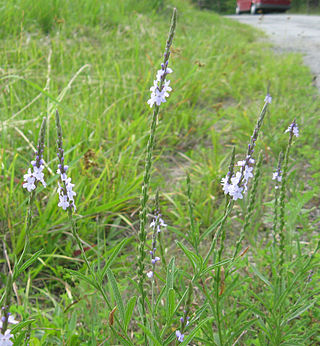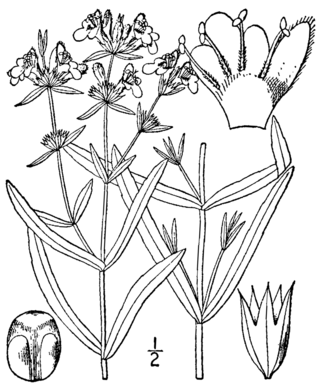
Rhynchospora is a genus of about 400 species of sedges with a cosmopolitan distribution. The genus includes both annual and perennial species, mostly with erect 3-sided stems and 3-ranked leaves. The achenes bear a beak-like tubercule and are sometimes subtended by bristles. Many of the species are similar in vegetative appearance, and mature fruits are needed to make a positive identification.

Rhynchospora capitellata is a species of sedge known by the common names brownish beaksedge and brownish beaked-rush. It is native to eastern North America and a few spots in the western United States. It grows in wet habitat, such as swamps, springtime meadows, and moist areas in forests. It is a perennial herb producing clumps of stems 20 to 100 centimeters tall, each stem sheathed with several narrow, pointed leaves. The inflorescence is a cluster of brown spikelets each about 3 or 4 millimeters long.
Scirpus longii is a species of flowering plant in the sedge family known by the common name Long's bulrush. It is native to eastern North America, where it is limited to the Atlantic coastal plain.

Verbena simplex, commonly known as narrowleaf vervain, is a perennial herbaceous plant plant in the Verbenaceae (vervain) family. It is native to central and eastern North America where it is found in open, dry, habitats on calcareous soil. It produces lavender flowers in the summer.

Carex cumulata, common names clustered sedge, piled sedge, and piled-up sedge is a species of Carex native to North America. It is a perennial.

Atriplex glabriuscula, common names Scotland orache, smooth orache, Babington's orache or seaside orach is an Atriplex species native to North America and northern Europe. It is an annual.

Liatris novae-angliae, commonly known as the New England blazing-star, is a species of flowering plant in the family Asteraceae.

Desmodium sessilifolium, common name sessileleaf ticktrefoil, is a species of plant in the legume family, Fabaceae. It is native to North America.

Botrychium simplex, the little grapefern, is a species of fern in the family Ophioglossaceae that is native to North America and Greenland. It is a perennial.

Calystegia spithamaea, which common names include: low false bindweed, low bindweed, erect bindweed, and upright bindweed, is a species of plant found in eastern North America.
Linum intercursum, common names sandplain flax and sandplain wild flax, is a perennial plant native to the United States.

Carex oligosperma, common name fewseed sedge, few-seeded sedge, and few-fruited sedge, is a perennial plant in the Carex genus. A distinct variety, Carex oligosperma var. oligosperma, exists.

Rhynchospora macrostachya, the tall horned beaksedge or tall beaksedge, is a plant in the sedge family, Cyperaceae. It is a perennial.

Carex sterilis, common names dioecious sedge, sterile sedge and Atlantic sedge, is a perennial plant native to North America.

Valerianella radiata, synonyms Valerianella stenocarpa and Valerianella woodsiana, common name beaked cornsalad, is a plant native to the United States. It is an annual self pollinating flowering plant and besides being mildly edible there are no known uses. Valerianella radiata flowers from April- May.

Carex typhina, common name cattail sedge, is a species of Carex native to North America.

Stachys hyssopifolia, commonly known as hyssop-leaf hedge-nettle, rough hedge-nettlehyssop-leaved hedgenettle, and hyssop hedge-nettle is a species of flowering plant in the mint family (Lamiaceae).

Panicum verrucosum, common name warty panicgrass, is a plant in North America. It is listed as a special concern and believed extirpated in Connecticut. It is listed as threatened in Indiana and Michigan, and as endangered in Ohio.

Potamogeton hillii, common name Hill's pondweed, is a species of plant found in North America. It is listed as endangered in Connecticut, Ohio, and Pennsylvania. It is listed as a special concern in Massachusetts and as threatened in Michigan and New York (state).

















